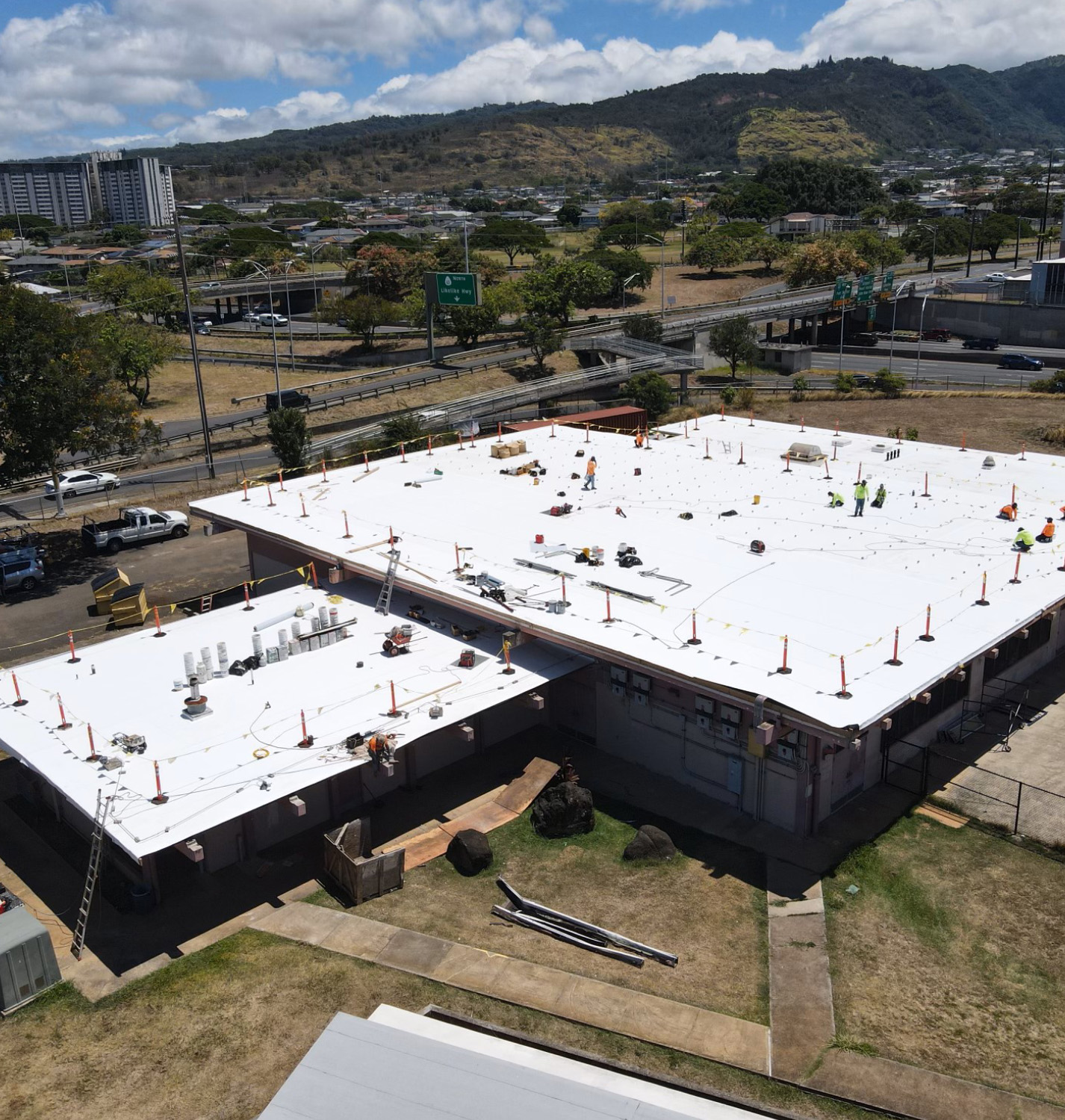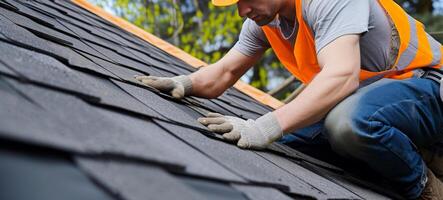Reveal Common Roof Problems and Just How to Address Them Successfully
When it comes to your roof covering, finding issues early can save you time and cash. What specific steps should you take to ensure your roof covering stays in leading condition?
Determining Roof Covering Leakages and Their Reasons

Following, analyze your roof covering from the outside. Look for missing or fractured floor tiles, rusted flashing, or harmed seamless gutters. Take notice of locations around smokeshafts, vents, and skylights, as these are common leakage resources. If you find any of these problems, it's vital to resolve them promptly.
Throughout heavy rainfall, observe your roof for any type of merging water or drips. This can expose leaks that may not be visible during completely dry conditions. By remaining cautious and consistently examining your roof covering, you can catch leakages early and shield your home from further damage.
Managing Missing or Damaged Tiles
When you see missing or damaged roof shingles, it's vital to act swiftly to avoid further problems. You'll desire to identify the degree of the damages, fix any kind of missing shingles, and think about preventative upkeep tips to keep your roofing system in leading form. Taking these actions can conserve you money and time in the future.
Identifying Shingle Damage
Although tiles are created to endure the elements, they can still endure damage over time, leading to potential leakages and costly fixings. To determine shingle damages, start by inspecting your roof covering for missing, fractured, or crinkled shingles. Consistently monitoring your roof, especially after severe weather condition, can help you capture issues early and keep the integrity of your home.
Fixing Missing Roof Shingles
After spotting tile damages, the next action is resolving any type of missing or harmed roof shingles quickly to prevent more problems. If you can, climb onto your roof securely, using suitable equipment. Taking action quickly will aid keep your roofing system's integrity and expand its lifespan.
Preventive Upkeep Tips
How can you keep your roof in top form and prevent roof shingles from going missing out on or getting harmed? Examine your roofing system at the very least twice a year and after serious climate (roofing honolulu hi).
Maintain gutters tidy and without debris to ensure correct water flow and stop tile damage. Trim overhanging branches to minimize the danger of them scratching against your roofing system throughout tornados.
Consider applying a protective sealer to expand your tiles' lifespan. Lastly, if you observe any kind of concerns, address them quickly to prevent expensive fixings later. Taking these safety nets can save you money and time while ensuring your roofing continues to be sturdy and reputable.
Recognizing Roof Covering Air Flow Issues
Correct roof ventilation is necessary for maintaining the longevity and effectiveness of your roof covering system, as it assists control temperature and moisture levels in your attic. Without adequate air flow, you could face problems like extreme warmth buildup, bring about early roof shingles deterioration, or raised moisture that can create mold development and timber rot.
To examine your roofing ventilation, check for indicators of getting too hot, such as distorted shingles or a warm attic room. Search for obstructed vents, which can limit air flow and catch warmth. You ought to guarantee your consumption and exhaust vents are balanced, enabling correct air exchange.
Resolving these issues without delay can protect your roof and save you from pricey repair work down the line. Keep positive in keeping your roofing system's air flow to protect your home.
Dealing With Roofing Moss and Algae Development
While you may value the natural look of moss and algae on your roof covering, these organisms can bring about substantial issues if left unattended. They trap moisture, which can cause roof shingles deterioration and leaks. To tackle this problem, beginning by eliminating any type of visible development. Utilize a soft-bristle brush to delicately scrub away the moss and algae, bewaring not to harm your tiles.
Following, take into consideration using a specialized roof cleaner or a mixture of water and bleach to kill remaining spores. Rinse completely to stop any kind of chemical damages. In addition, mount zinc or copper strips along the ridge of your roof covering. As rainfall cleans over these steels, it produces a safety barrier against future growth. Regular evaluations and maintenance will help protect against moss and algae from returning, ensuring your roof remains in good form for years ahead.
Repairing Tornado Damages and Wind Problems
After a storm, it's essential to evaluate your roof for damages caused by high winds and hefty rain. Beginning by checking for missing out on or broken tiles, as these are common casualties.
Seek any drooping areas, which may indicate water build-up or structural problems. If you locate any type of particles, like branches or leaves, remove them very carefully to avoid additional damage. If your rain gutters are obstructed, clear them to guarantee correct drainage.

For small repair services, you could handle it yourself, however do not be reluctant to call a professional for substantial damages. Bear in mind, acting quickly can save you from bigger issues down the line, so take that analysis seriously and resolve any issues immediately.
Recognizing Signs of Structural Damage
Exactly how can you tell if your roofing is experiencing architectural damages? Beginning by seeking visible sagging or dips in your roofline. These signs indicate that the underlying structure may be compromised. Next off, look for splits or voids in the wall surfaces or ceiling, as these can signify changing or resolving as a result of roof covering concerns. Focus on leakages or water discolorations, particularly in areas where the roofing system satisfies walls. If you notice missing or damaged tiles, it's necessary to resolve them swiftly, as they can subject your roofing system to further damages. Inspect your attic room for any type of signs of daytime glimpsing with, which could indicate your roofing's integrity is at threat. Listen for unusual creaking or popping noises, as they may suggest architectural anxiety. If you observe any of these signs, it's time to get in touch with a roof professional for a thorough analysis.
Routine Maintenance Tips for Long Life

Routine Assessments Value
Given that a roofing is your home's initial line of defense against the components, regular assessments are important for keeping its integrity. You must examine your roofing system at the very least two times a year, ideally in spring and loss, to catch prospective concerns early. Maintaining up with these evaluations can stop pricey repair services down the line and extend your roof's life expectancy, guaranteeing your home continues to be safe and sound for years to come.
Correct Gutter Upkeep
Regular roof covering examinations naturally lead to the importance of correct rain gutter maintenance. Inspect your seamless gutters for leaks or rust; they can cause water damages to your roofing system and home. By following these ideas, you'll prolong your seamless gutters' life expectancy and protect your roofing.
Frequently Asked Inquiries
Exactly How Can I Pick the Right Roof Product for My Home?
To choose the appropriate roofing product for your home, consider environment, sturdiness, and visual appeals. Study options like asphalt roof shingles, steel, or ceramic tile. Consider upkeep demands and click here to read budget plan to Discover More locate what suits you finest.
What Are the Indicators I Need a Roofing Substitute As Opposed To Repair Service?
If you see widespread leaks, drooping, or missing out on shingles, you may require a roof replacement. Likewise, if your roof covering's nearing its lifespan or has considerable damages, it's time to ponder a full replacement rather than simply fixings.
Exactly how Usually Should I Schedule Professional Roofing System Assessments?
You must set up specialist roof covering inspections at the very least once a year, ideally in spring or fall. This helps catch potential issues early, ensuring your roofing system remains in good problem and prolonging its life-span.
Can I Mount a New Roof Covering Over My Old One?
You can mount a new roof covering over your old one, however it's important to check neighborhood building ordinance and guarantee the existing roofing's condition is audio. This approach can save money and time, yet consider prospective complications.
What Is the Average Lifespan of Various Roof Covering Products?
The average lifespan differs by product: asphalt roof shingles last 15-30 years, metal roofs can last 40-70 years, while floor tile or slate roofings may exceed half a century. Select carefully based on your environment and budget plan.
Conclusion
By remaining attentive and attending to common roof covering issues quickly, you can protect your home and prolong your roofing system's life-span. Consistently check for leaks, harmed shingles, and air flow issues, and take on moss or algae growth prior to it intensifies - roofing honolulu hi. After storms, check for any damages and make required repair services. With a little regular maintenance, you'll not just protect your financial investment but likewise enjoy assurance recognizing your roof is in leading shape. Don't wait-- act currently!